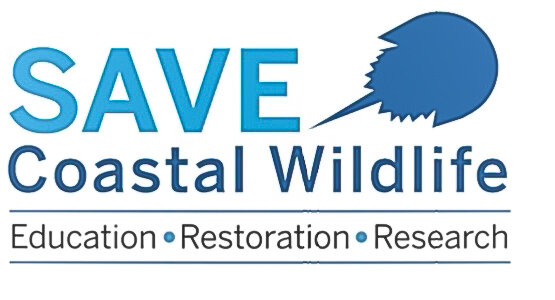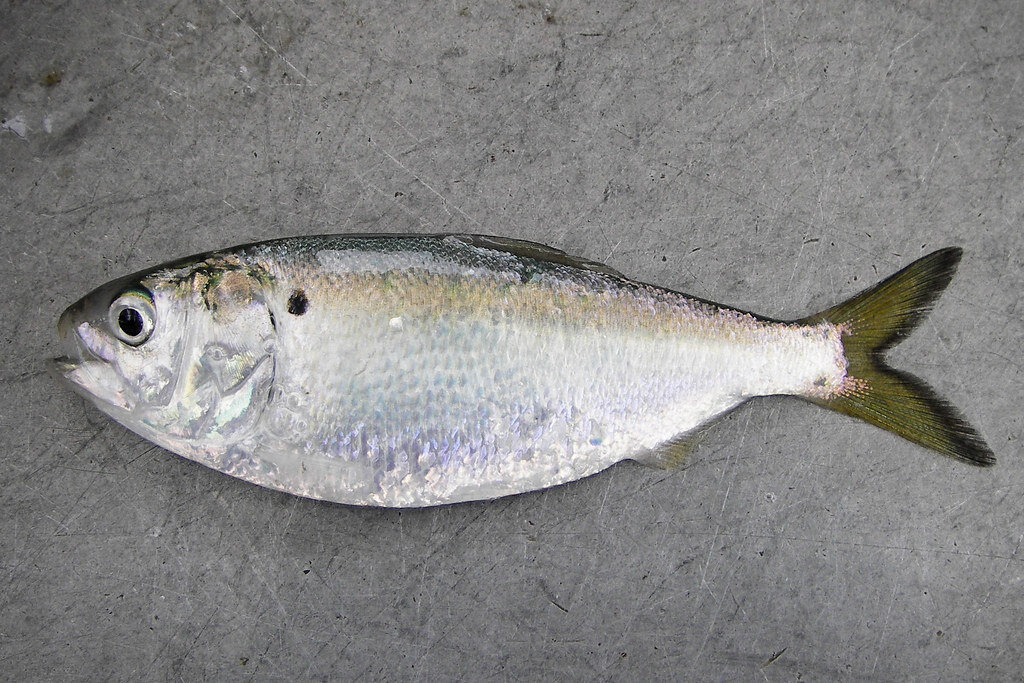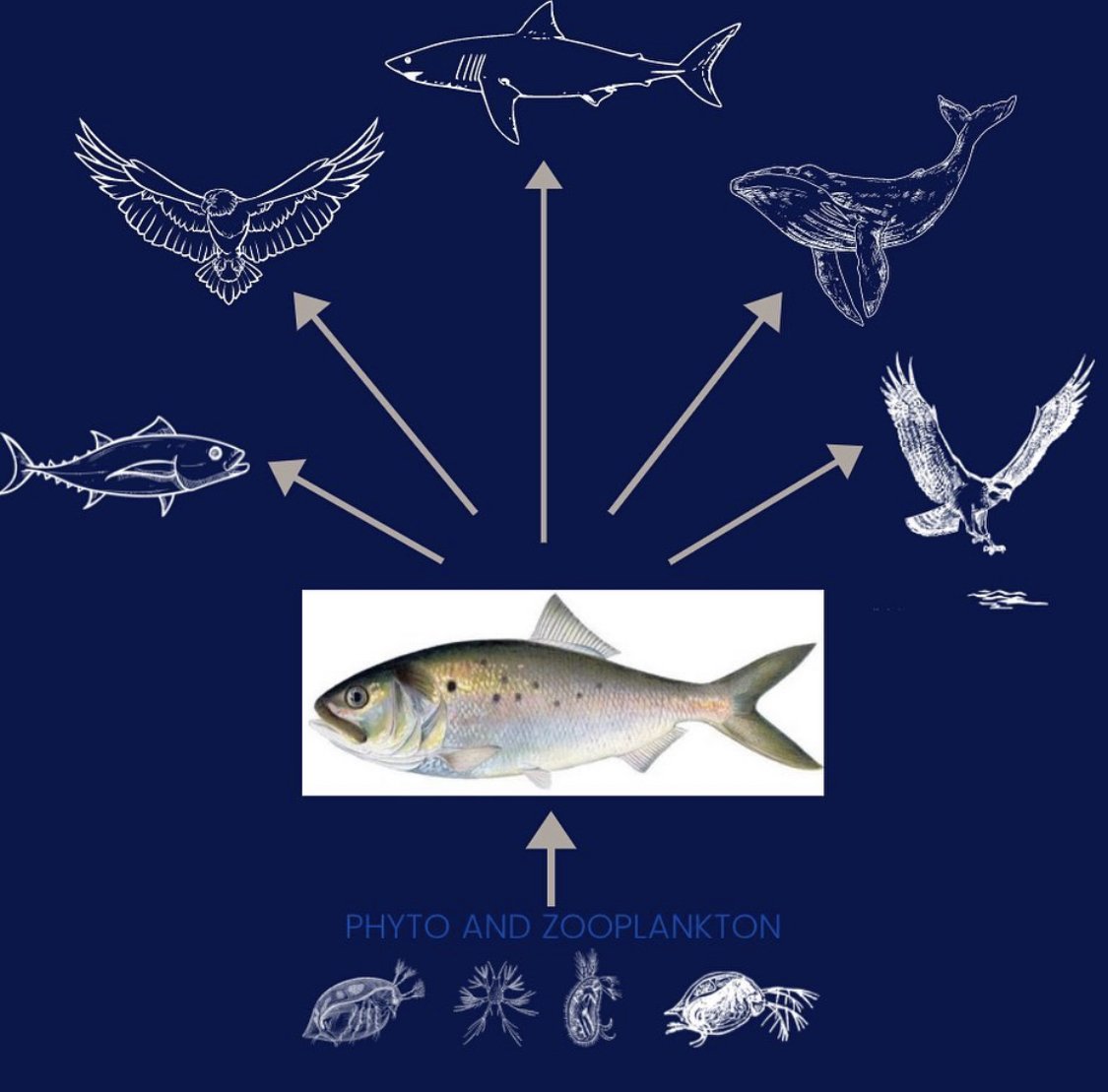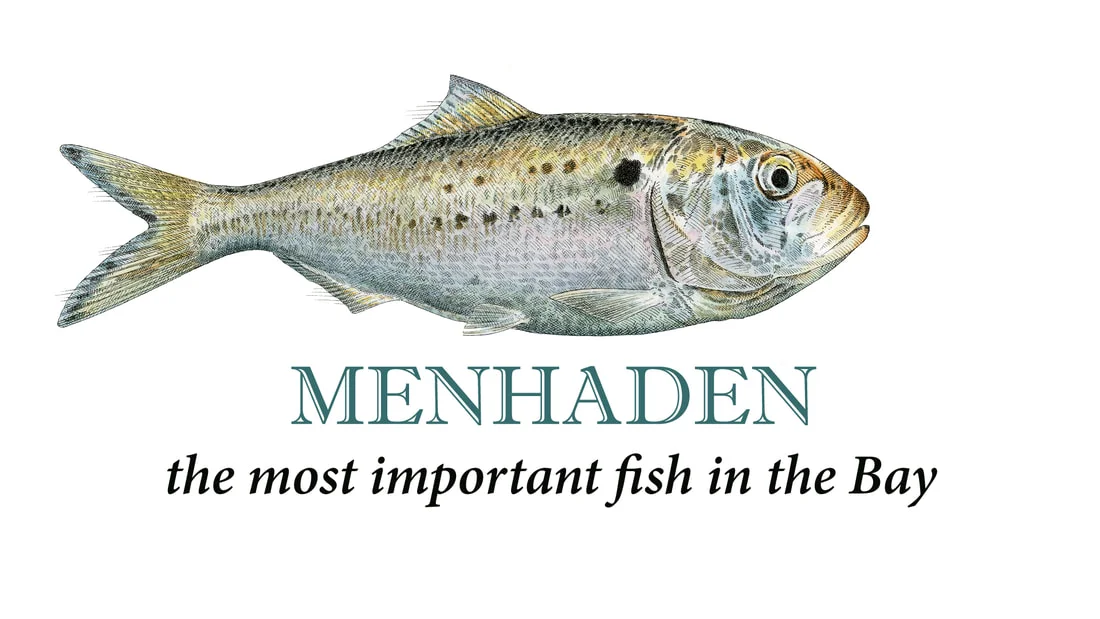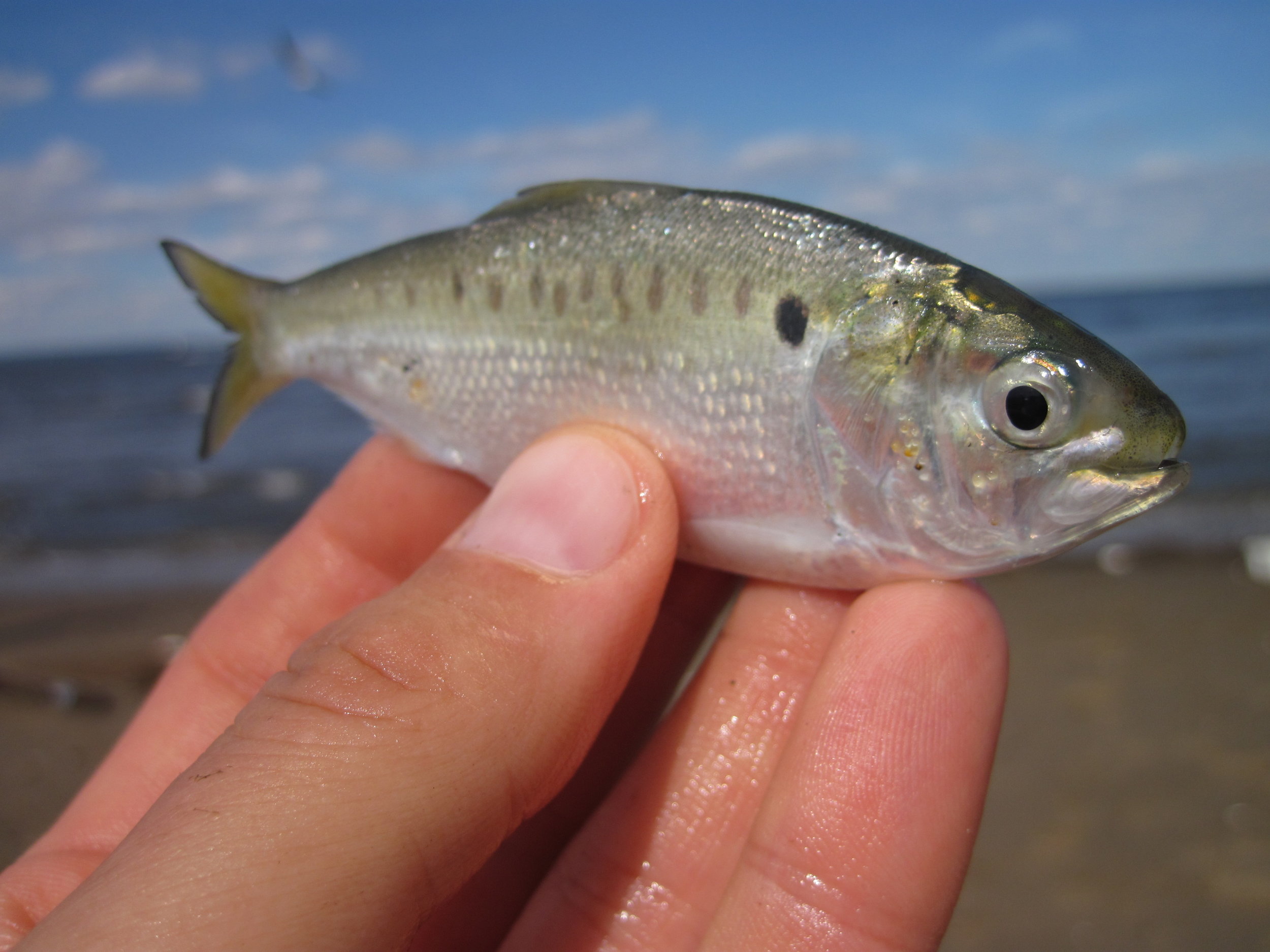Save Atlantic Menhaden!
“The Most Important Fish in the Sea that Most People Don’t Know”
What Are Menhaden?
Atlantic menhaden (Brevoortia tyrannus), also locally known as bunker, moss bunker, pogy or fatback, are schooling forage fish related to herring, shad, and sardines.
Menhaden or bunker are an important food source for many coastal animals.
Atlantic menhaden are common fish in estuaries and coastal waters from Nova Scotia to northern Florida. Menhaden are small, flat-bodied, fish with deeply forked tails. They have bright silver scales, and are characterized by a series of smaller dark spots behind the main, black humeral spot.
Adult and juvenile menhaden form large, near-surface schools, primarily in estuaries and nearshore ocean waters from early spring through early winter. By summer, menhaden schools stratify by size and age along the coast, with older and larger menhaden found farther north. During fall-early winter, menhaden of all sizes and ages migrate south to waters off the North Carolina Coast.
A large school of Atlantic menhaden feeding on plankton.
Life Span: Between 10 to 12 years. Adults can grow to be around 15 inches.
Reproduction: Atlantic menhaden can spawn year round in nearshore waters off the Atlantic coast, with the highest spawning rates near North Carolina in the late fall. Buoyant eggs hatch in the open ocean and the larvae drift to sheltered estuaries via ocean currents.
During March and early April, adult menhaden gather and migrate northward to spawn in the spring and again in the fall, September to October. Sexual maturity begins as early as age one to just before age three, with major spawning areas from the Carolinas to New Jersey. The majority of spawning occurs primarily offshore (20-30 miles) during winter. Juveniles spend most of their first year in estuaries, migrating to the ocean in late fall. Juveniles can grow rapidly through the summer to reach sizes up to 7.2 inches by fall.
Why Are Menhaden the Most Important Fish in the Sea???
Humans do not eat menhaden directly, not even in fish tacos! The fish are too oily and bony. Instead these small fish create an important link in an estuarine-marine food web. Menhaden are a key source of omega-3 fatty acids and nutrients, which are essential for regular and robust body functions and growth in animals. Menhaden are also an important source of protein for many species, including bluefish, dolphins, eagles, humpback whales, ospreys, sharks, striped bass, dolphin fish, herons, egrets, terns, and weakfish. All these species and other sea creatures depend on this one fatty fish for food and survival.
Many species of coastal birds, fish and marine mammals depend on menhaden for their survival as a food source.
Whales, dolphins, and other marine mammals devour them in large numbers; a variety of sharks are often seen following menhaden schools; pollock, cod, silver hake, and swordfish all depend on menhaden for nourishment in the Gulf of Maine, as do weakfish south of Cape Cod. Tuna also devour great numbers, and bluefish depend on menhaden for their survival every summer.
When menhaden populations are high, a surge of life is seen along the coast. Whales and dolphins have returned to New York Harbor in enough numbers that a company in Brooklyn can reliably trot tourists out to the ocean—within distance of Manhattan’s skyscrapers—to see them. Osprey populations and other fish eating birds do better in years when menhaden populations are high, shark populations also re-bound, and high-value recreational fish including striped bass and bluefish have plenty to eat and people have plenty to catch when menhaden populations are abundant.
Atlantic menhaden are schooling fish and are filter feeders. They feed on both phytoplankton and zooplankton.
Do you hear it? All these “snaps” in the water are a large school of menhaden with tails sticking out of the water feeding on an even larger population of plankton. Picture taken in Sandy Hook Bay, NJ.
Menhaden have a perfect mouth to feed on plankton. The menhaden fish is a filter-feeder that feeds by swimming rapidly in the water to capture plankton in its open mouth, either phytoplankton or zooplankton depending on age (older fish eat zooplankton). Menhaden feed by straining plankton and algae from water, then helping to provide cleaner water in return.
Moreover, as stated above, Atlantic menhaden are filter feeders. They feed on algae and zooplankton, and clean the water they filter through their digestive system. Menhaden can filter huge amounts of algae, nitrogen, and plant detritus from our estuaries, and clean waters at an incredible rate. Some scientists have suggested that one adult menhaden can clean four to six gallons of water in a minute! Quite simply, menhaden help to keep our coastal waters clean.
The Atlantic menhaden feeds by opening its mouth and allowing water to pass through its gill openings, which filter microscopic plants and small crustaceans from the water. In calm water, the snouts or tails of the menhaden can come out of the water as they feed on surface-dwelling plankton.
Author H. Bruce Franklin was absolutely correct when he named his book about menhaden, The Most Important Fish in the Sea. Menhaden make up the foundation for estuarine and marine food chains. So many sea creatures along the East Coast depend on this oily forage fish, from marine mammals to birds to sea turtles to big fish. In addition to their important role in the food chain, menhaden are filter feeders and act as natural filters for an estuarine-marine ecosystem.
A large school of Atlantic Menhaden or Bunker (Brevoortia tyrannus) was spotted on Wednesday, August 12, 2020 swimming and feeding on plankton near the shoreline of Sea Bright, NJ.
The Problem:
Menhaden populations have plummeted 90 percent over the past 30 years.
The decline threatens to disrupt coastal and marine food webs and affect thousands of fishing, whale-watching, and bird-watching businesses that menhaden help support.
Menhaden support one of the most commercially important fisheries along the Atlantic Coast, providing fish meal, fish oil, and bait for other fisheries. More pounds of menhaden are landed each year than any other fish in the United States.
Historically we have done a very poor job of managing this fish. Menhaden have been consistently overfished for more than a century. Populations of menhaden used to burst in coastal waters from spring through fall. In some early European accounts, large populations of menhaden were “40 miles long and two miles wide, from the surface to the sea-bed.”
In 1879, George Brown Goode, the noted Smithsonian museum administrator, historian of science, and ichthyologist, released his monumental publication, The Natural and Economical History of the American Menhaden, the first, and still one of the the most comprehensive, studies of an American fishery. In 1880, Goode wrote that we were running out of menhaden. The schools that Goode had studied, primarily north of Cape Cod, were gone. Even today, the menhaden’s range is a small fraction of what it once was. Yet, we continue to fish for them.
There are two main types of fisheries for menhaden:
1. Reduction" (industrial) menhaden fishing. Today, Virginia is the only state that allows "reduction" (industrial) menhaden fishing, which takes approximately 80 percent of the catch coast-wide. The oil and fish meal from the catch goes into paints, cosmetics, animal feeds, and human diet supplements. This reduction fishery removes approximately 80,000 tons of menhaden from the Virginia part of the Chesapeake Bay as well as in the Atlantic Ocean each year.
Omega Protein (NYSE: OME), a company based out of Houston, Texas, dominates the menhaden reduction industry, taking the majority of the Atlantic Menhaden catch and operating the only processing facility on the East Coast, which is located in Reedville, Virginia. They use purse seine fishing as a method to catch menhaden.
2. The commercial bait fishery has been growing since 1985 and now makes up about one quarter of the menhaden harvested along the Atlantic coast. A majority of the menhaden‐for‐bait landings are used commercially in crab, lobster, and hook‐and‐line fisheries. Recreational fishermen also catch Atlantic menhaden as bait for various game fish. Bait harvest in 2016 was estimated at 97 million pounds and represents 24% of total menhaden landings. The largest state contributors to the bait fishery are New Jersey (47% of bait landings in 2016) and Virginia (34% of bait landings in 2016).
The Atlantic menhaden fishery is managed by the Atlantic States Marine Fisheries Commission's (ASMFC) Atlantic Menhaden Management Board, which tracks and regulates harvest under Amendment 2 to the Interstate Fishery Management Plan for Atlantic menhaden.
What’s Being Done?
The latest population assessment by the ASMFC (Atlantic States Marine Fisheries Commission) was completed in 2017. While the menhaden population is recovering, it is still a long way from being healthy and certainly a long way from fulfilling all the forage needs of whales, dolphins, ospreys, striped bass and other coastal species.
The new assessment only shows the status of the menhaden population independent of other species and not its contribution to a coastal food web.
Industry and conservationists debate future of the species, Rhode Island, 2017
While some recent decisions mark victories for menhaden conservation, Save Coastal Wildlife Nonprofit and other environmental groups are disappointed that the ASMFC will not immediately adopt catch limits that would take into account menhaden's important role in a coastal food chain.
The ASMFC argued that the guidelines being considered were based on other species in other locations and has decided to wait to move forward until technical work groups have finished developing ecosystem-based models specifically for menhaden. That effort is expected to be completed in 2019.
Save Coastal Wildlife strongly believes the only way to make sure we have healthy coastal ecosystems is by taking a look at the entire estuarine-marine system, including the menhaden fishery. What remains after many decades of industrial overfishing and mismanagement is not nearly enough to support a healthy coastal community from humpback whales to bluefish to bluefin tuna to people.
Current fishery activities of menhaden may lead to an extremely low population along the Jersey Shore, so low that it could undermine menhaden's important ecological role as a filter feeder and to serve as a major food source for other fish, marine mammals, and important coastal species.
WHAT CAN YOU DO TO HELP SAVE MENHADEN:
You can write your members of Congress in Washington D.C. as well as the US EPA (United States Environmental Protection Agency) telling them to better regulate the menhaden fishery.
You can avoid products with fish oils including fertilizers, dietary supplements with fish oil, and many kinds of pet foods and cosmetics that contain fish or fish oil (many brands of lipstick have been known to contain fish oils in order to give the lipstick a slippery feel on the skin).
Menhaden is also processed into feed for poultry and pigs, which makes this a good time to think about your diet and how what you eat affects the environment.
A juvenile menhaden fish caught in a seine net in Sandy Hook Bay during September.
A BRIEF OVERVIEW
An Environmental History of Menhaden:
An essential fish in the history of the United States of America!
At first glance, Atlantic menhaden do not appear like an impressive fish. It’s small in size, often growing to 14 to 18 inches in length. The Narragansett native people, a group of aboriginal people in the State of Rhode Island, once called them munnawhatteaug, which means “that which manures.”
Menhaden were probably the fish that indigenous people who lived along the east coast (along with the original settlers of the Plymouth Colony, known simply as the Pilgrims) used to place next to their corn or crops as fertilizer. Native Americans showed the Pilgrims how to grow corn by planting a fish with each corn plant. The Mayans, Incas and Native Americans of the southwest all used fish to grow crops to get nitrogen, potassium and phosphorus into the soil.
Before 1850, menhaden were used only as fertilizer and as bait to catch Atlantic mackerel (Scomber scombrus) and cod (Gadus morhua) in the ocean. Probably in the 1850's or 1860's, extraction of oil from menhaden in factories began. By the late 19th century, fish processing plants were numerous up and down the eastern seaboard of the United States of America.
What makes Menhaden so good at being fertilizer?
It contains some of the highest concentrations of omega-3 fatty acids in all of nature! A key, nutritive compound of fish oil.
Throughout the 1700s and 1800, these oily and strong smelling fish were rarely eaten. Instead menhaden were used as baitfish or thrown whole on farm fields for fertilizer.
In the 1800s, the menhaden fishery came into its own when commercial fish processing plants began appearing along the east coast from southern Maine to northern Florida. The fish were cooked and pressed, the oil was used to make soap and fuel for lanterns. The solids were ground up for fertilizer and animal feed.
By 1880, half a billion menhaden were being rendered into oil and fertilizer.
An airstrip where “spotter” plans would take off and land to locate schools of menhaden for the Belford fish factory that once existed in Belford/Port Monmouth, Middletown Township, NJ.
As technology improved, airplanes became an important part of menhaden fishing all along the east coast. Planes would take off from areas near fish factories, spot fish and radio down to fishing ships below.
There were almost three times as many menhaden ships as whaling ship. A menhaden boat could produce more oil in a week than a whaling ship could during it’s entire, multi-year voyage, and it could do so close to shore and largely out of harms way.
In Delaware from the late 19th to mid 20th centuries, the shores of Lewes Beach were lined with fish factories that processed the fish and sent it out across the country. In 1953, Lewes was the largest seafood port in the United States, processing over 390 million pounds of seafood, 360 million of which were exclusively menhaden.
The menhaden fishery grew in the United States and reached peak landings in 1956 at 712,100 metric tons.
A Closer Look At The J. Howard Smith Menhaden Factory in Port Monmouth, NJ.
Around 1900, the Port Monmouth-Belford area in Middletown Township, New Jersey had three small menhaden reduction factories. Eventually, these factories would become part of the J. Howard Smith Company. Mr. Smith would turn several small factories along Sandy Hook Bay into a big business, and which for the day (the 1940s & 1950s) had became Middletown Township’s largest industry and employer.
In 1911, a serious illness forced J. Howard Smith, a lawyer in New York City, to seek another way of life. Along with his brother Gilbert, they decided to follow what had been their father’s dream of starting a factory to manufacture fish oil and fertilizer from the menhaden fish.
Within two months after the doctor’s diagnosis, the brothers purchased a small area of land in Port Monmouth, part of Middletown Township, NJ to begin business. Soon after, J. Howard gathered up his family, his wife and three small children to live near the factory.
In addition to the factories, J. Howard bought a large vat in which he cooked the fish purchased from the local pound fishermen. After it was finished, the oil was crushed out in a small cider press and the scrap residue spread out on flat boards to dry. This was eventually sold as fertilizer. The oil was shipped to New York City in steel drums to a distributing company. While the industry flourished, local residents had a hard time accepting the menhaden factory. In the days before deodorizers were invented, the smells of cooking and drying fish were difficult for neighbors to live with, but as legend has it, the “good folks of Port Monmouth and Belford seldom complained.” When farming and fishing were the main occupations in the area, residents rarely objected to it. BUT as more people moved to the area beginning in the 1950's after World War II, many residents started to complain about the odor to local health authorities and politicians.
By the 1940s, J. Howard Smith owned nine menhaden plants (including one in Beaufort, North Carolina, and Reedville, Virginia, a facility now owned and operated by Omega Protein). But the largest and parent plant for J. Howard Smith was located in Port Monmouth, New Jersey. Later, all the plants were managed by Smith’s three sons. In 1941, Peter Cubbage took over management of the Port Monmouth plant as executive president, as the sons of J. Howard were successfully operating other plants along the east coast.
In 1981 Seacoast Products, Inc., (formally known as J. Howard Smith Co.) fish factory closed permanently, due to the decline of menhaden oil. Soybean oil had become cheaper, and financially the cost of running a fish factory was more expensive on the Atlantic Coast compared to places along the Gulf of Mexico. In addition, over-fishing by Atlantic coast fleets and fishermen had reduced the population of menhaden to make the industry unprofitable along the East Coast of the United States.
Former Menhaden Factory, Beaufort NC
Above Picture taken at the Local Market and Kitchen in Ship Bottom, NJ in 2018. The bag is on display in the bathroom. Smith’s Fish Meal company in Tuckerton was owned by J. Howard Smith, one of many owners of the fish factory on land known as Crab Island which is part of a group of islands collectively known as ‘Seven Islands’, located in the Great Bay, Little Egg Harbor Township, New Jersey.
By the 1970s, many of the menhaden “fish factories” along the east coast began to close due to increasing competition from chemical fertilizers and dwindling populations of menhaden. For most of the history of the menhaden fishery, oil and fertilizer were the fish’s primary uses.
Today, menhaden fish oil is largely used as a nutritional supplement, aiding in heart, bone and even emotional health for humans, and as an essential ingredient in many lipsticks, paints, and pet foods.
While the population of Atlantic menhaden has been deemed “not overfished” by the Atlantic States Marine Fisheries Commission (ASMFC) in 2019, the history and importance of this species cannot be ignored.
The current menhaden fishery should not be examined solely on the size of its population from a decade or so ago. Fisheries management of menhaden must take into account the important ecological value this one species of fish provides to all species in or near coastal waters, from people to fish to birds to marine mammals.
Menhaden fish factories located along the East Coast of the United States in 1955.
Locations of menhaden reduction plants in 1955 (dots) and the areas for which statistics on catch and biology were compiled.” From: Reintjes, J. W. (1969) Synopsis of Biological Data on the Atlantic Menhaden, Brevoortia tyannus. FAO Fisheries Synopsis No. 42 U. US Department of the Interior, US Fish and Wildlife Service, Bureau of Commercial Fisheries – Circular 320-1969
